Great Hanshin (Kobe) Earthquake 阪神大震災
|
Title   • File Name • File Name   • Date • Date   • Position • Position   |
|

Since Jan. 2010 is the 15th anniversary of the Kobe earthquake that struck on Jan. 17, 1995, I decided to upload these photos for the first time. I visited Kobe 10 days after the killer quake struck. Had to take a hydrofoil from Osaka to reach Kobe.
|
|

Kobe Port. Most of the people entering Kobe during this time were relatives and friends of Kobe residents, bringing relief goods.
|
|

Distribution place for relief goods. Ten days after the earthquake, the initial fires, confusion, and pandemonium had subsided. It was pretty calm by then, but the damage was still visible.
|
|
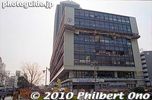
Kobe City Hall buckled at the middle floor.
|
|

Near Kobe City Hall along Flower Road was this office building which had also collapsed at a middle floor.
|
|

Santica building near Sannomiya Station had a middle floor crushed. As I walked around the devastation, I could see common ways in which the buildings collapsed. High rise buildings commonly collapsed on a middle floor.
|
|

Kobe Shimbun newspaper offices near Sannomiya Station was in shambles.
|
|
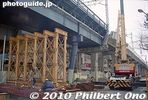
Expressway pylon broken.
|
|

In front of Sannomiya Station is Sogo Dept. Store.
|
|
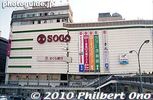
Sogo Dept. Store cracked vertically in the middle. This building was later torn down and replaced with a new dept. store building.
|
|

Cracked Sogo Dept. Store in Sannomiya.
|
|
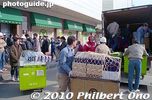
Employees are removing merchandise from Sogo Dept. Store.
|
|

Shop shutters along Ikuta Road are tilted due to the crushing weight.
|
|
|

Tilted buildings near Sannomiya Station. It took only 15 sec. to wreak all this damage.
|
|

The building next to Washington Hotel scraped against the hotel as it fell.
|
|
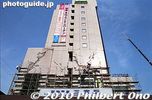
Damage to Sannomiya Station building.
|
|

Sannomiya Station
|
|
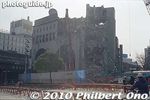
Hankyu Railways' Sannomiya Station being torn down.
|
|
|

Nihon Seimei Bldg. collapsed at the middle.
|
|
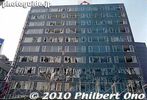
Nihon Seimei Bldg. collapsed at the middle, near Sannomiya Station. It's hard to imagine what would've happened if the quake struck during working hours with people working in this building.
|
|

A mess inside a restaurant.
|
|

Fallen clock which stopped at the time of the earthquake.
|
|
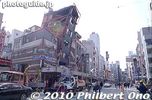
No, my camera lens is not distorting this picture. That building is actually tilting a lot, but they still allowed traffic on the road below.
|
|
|
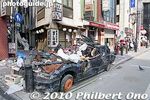
Crushed car
|
|
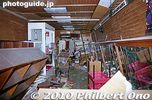
Store in shambles.
|
|
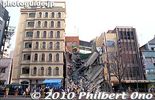
Interesting contrast between buildings which fell and didn't fall.
|
|
|

Amid the rubble of a collapsed building, a yakisoba stall sold yakisoba noodles.
|
|

People eating yakisoba amid the rubble.
|
|

Another common way in which buildings collapsed was the 1st floor giving way like this small hotel.
|
|

The 1st floor is totally flattened.
|
|

One hotel guest escaped by using bed sheets as a rope.
|
|
|

Backstreet destruction.
|
|
|
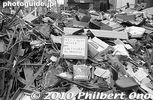
Sign saying they are okay.
|
|
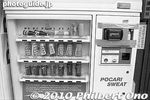
Vending machine
|
|
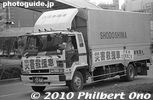
Truck carrying relief goods.
|
|

Boxes of food (biscuits).
|
|

A building owner stands by her destroyed building.
|
|
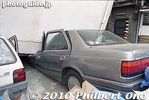
Crushed car
|
|

In the Kitano area where there are many Western-style homes, the damage was not so apparent. But the interior sustained damage. None of the buildings collapsed though.
|
|

Weathercock House, built in 1909, withstood the quake.
|
|
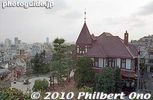
Only the chimney broke off atop the Weathercock House. The inside is a different story.
|
|
|

Water station
|
|
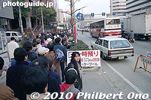
Line for the bus headed for Ashiya Station.
|
|

Bus for Ashiya Station, the furthest that trains could go at the time. Trains weren't running within Kobe.
|
|
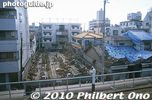
The next day, I again visited Kobe, this time by train to Ashiya Station. See gravestones overturned.
|
|
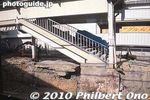
Ashiya Station platform.
|
|
|
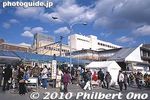
Ashiya Station
|
|
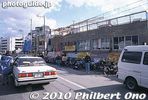
Collapsed shopping center near Ashiya Station. That's the 2nd floor which now looks like the 1st floor.
|
|
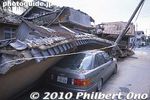
Crushed Audi.
|
|

This house stood firm, while its neighbor collapsed.
|
|

Not a good idea to live in a house standing right next to another building.
|
|
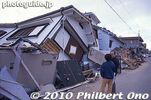
Houses along the train tracks in Ashiya. Basically, Japanese-style homes with heavy tile roofs collapsed easily, while concrete homes withstood the quake better.
|
|
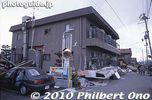
Collapsed 1st floor of an apt. building. I don't recommend living on the 1st floor of any building in Japan.
|
|
|
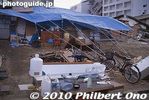
House covered by a blue tarp to protect against rain.
|
|
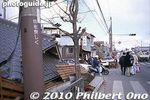
Sign says, "Keep our town beautiful."
|
|

Another distinct pattern was buildings on stilts easily collapsing.
|
|
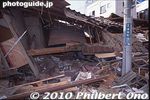
A makeshift altar placed on the collapsed home. Someone died here. By the time I visited, most of the trapped people had been rescued.
|
|
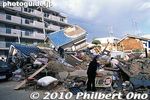
Sifting through the rubble.
|
|
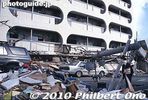
I really felt sorry for the people who had just bought a house or condo with a 35-year mortgage and the house or condo was destroyed by the quake. They are stuck paying off the housing loan and also have to pay monthly rent at a new place.
|
|
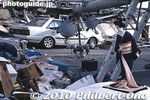
At least they recovered some things.
|
|
|
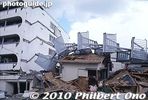
The emergency stairway got torn off this building whose first floor got crushed.
|
|

Something they needed the most was torn off the building. If you live in a high-rise building in Japan, have ropes ready in your veranda in case your stairway is destroyed like this.
|
|

When you look at these toppled homes, you cannot help but think that they do look flimsy with thin walls. The problem is, such cheaply-made homes are very common in Japan.
|
|
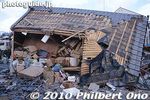
The Japanese tile roof makes the home top-heavy, making it more vulnerable to horizontal swaying and eventual toppling.
|
|

The famous scene of the expressway collapsed on its side was completely gone 10 days after the quake. They had cleared the collapsed section (about 600 meters) of the road.
|
|

The collapsed expressway was so embarrassing that they made it a priority to clear it ASAP.
|
|

The expressway that supposed withstand such quakes collapsed. It was a major scandal. The shinkansen bullet train tracks also had broken concrete columns which revealed pieces of scrap wood mixed in.
|
|

The engineers said this would be strong enough, but they were dead wrong.
|
|
|
|
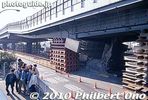
Earthquake tourists getting their picture taken.
|
|

Fukae Shopping Center
|
|
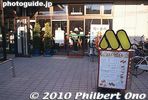
I was amazed to see Mos Burger back in business so soon. It was another sign of a very progressive recovery.
|
|
|
|
|